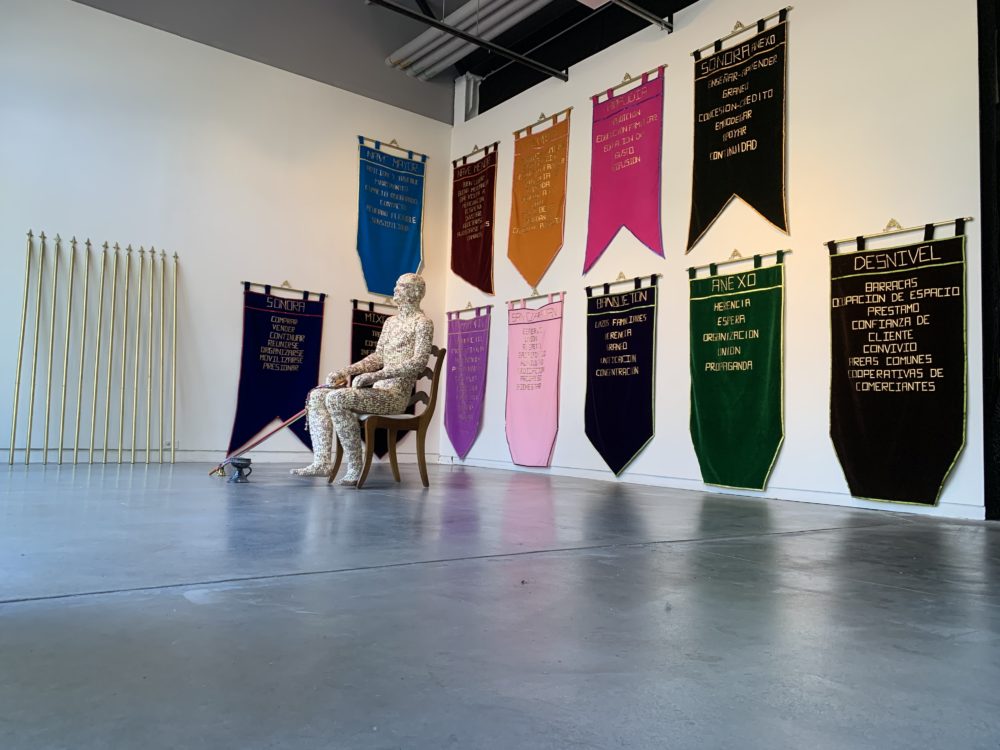Alfadir Luna: Seí±or de Maíz / Corn Man


Procession to Unite a Man of Corn / Procession of the Corn Man
NOTE: Alfadir Luna’s exhibition is a storefront installation that can be viewed anytime from GCAC’s 2nd Street promenade.
Text by Xochi Maberry-Gaulke
Alfadir Luna is a social practice artist based in Mexico City who takes a cosmological and philosophical approach to knowledge- sharing and community engagement. His work primarily takes the form of drawing and performative actions; it begins as reflections revolving around knowledge processes, which usually culminate in site-specific interventions. For Luna, art is understood as a form of knowledge, a kind of relationship between ideas and objects that create models of thinking that intimately relate to the bodily experience.
For instance, this was expressed most poetically in a five-year performance project called La Piedra, in which Luna took the site of a single object—a specific rock found in a dry riverbed—as a point of departure to understand site, creation, and the internal versus external bodily experience. He developed an obsessive relationship with the rock through daily observation; hundreds of drawings and writings about the rock slowly revealed knowledge that had been previously locked inside. As the secrets became released and shared with Luna, they evaporate into layers of knowledge around the object, which can be seen as a metaphorical unlocking of ancient sacred knowledge. Developing this unique process of learning has been an instrumental tool for Luna to project the self outwards through a new kind of mirror.
Since 2006 Luna has developed his work within the framework of the social structures that constitute public markets in Spanish-speaking contexts. Committing to a ten-year engagement working with merchants at the Mercados Píºblicos [Public Market] in the historic La Merced market in Mexico City, he realized this community had a very different understanding of identity and knowledge than he had developed during La Piedra. La Merced itself is divided into sections according to the type of goods sold (produce, auto parts, gifts, etc.) and is guided by five principles: money, commercial exchange, religion, magic, and love/affection. These guiding principles are never separated and are inherently interlocked; they connect each section of the market with a kind of mythic energy current. Organizing the community of merchants to collaborate with one another was an important focal point in Luna’s commitment to the merchants in La Merced. Another manifestation that connects the markets is a monthly saint procession throughout La Merced that combines performance with politics and religion.
Luna wondered what would happen if he removed the saint from the procession and replaced it with an open signifier, a metaphorical seed to spark conversation and sprout a new way of thinking about the mythic and political energy of La Merced. This metaphorical seed is the Seí±or de Maíz, or Corn Man. With each part of its body made by a different market within La Merced, the Seí±or de Maíz has replaced the saint in the monthly processions. To determine the impact of the new embodiment of the mythic signifier, Luna conversed with the merchants and porters on the procession’s new addition: some people continued to treat him as a saint, while others feared him.
Why corn? The corn references indigenous communities in Central Mexico and various situations of impoverished farmers or their declarations against local government. The name also refers to a traditional farming technique in which farmed goods are piled up as a method of protecting it from animal predators. In this sense, the corn is both protector and that which is protected. While the merchants and porters aim to protect indigenous corn, the government protects large farming companies like Monsanto. Because the Seí±or de Maíz embodies such significance and magic for La Merced it must be made with all local ingredients and cannot travel. Therefore, this Seí±or de Maíz is not the original; it was made buy the artist in collaboration with local merchants and Cal State Fullerton student Alejandro Olivares in Downtown Santa Ana, California – an historically important destination for Mexican migrants – while in residency at Grand Central Art Center. Corn Man was made in collaboration with the Ben Maltz Gallery at OTIS College of Art and Design for the 2017 Pacific Standard Time exhibition Talking to Action. The art work figure is made with locally US-sourced corn kernels that are not genetically modified Monsanto seeds. Since the power and energy of the Seí±or de Maíz is always tied to the power and energy of site, with this difference in corn, community and location, this iteration tells a different story than the one in La Merced.
Given this relationship, the Seí±or de Maíz will return to the merchants of Santa Ana as the exhibition national tour of Talking to Action has completed. In addition to OTIS, the exhibition traveled to the Art Institute of Chicago, Pratt Manhattan, and Arizona State University Art Museum. Corn Man‘s return to the community ceremony was originally planned to take place in late Spring of 2020 as the artist was scheduled to once again be in residence, but has been paused due to the COVID-19 crisis. A visit by the artist will be reschedule when such travel is safe for the artist and our community.